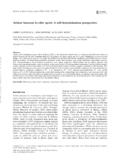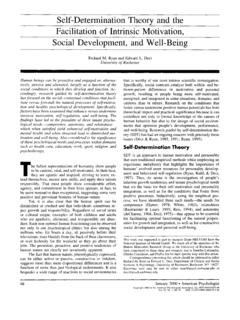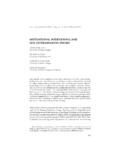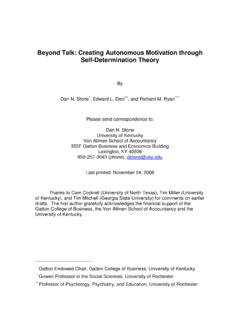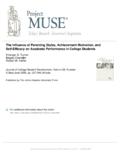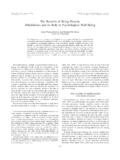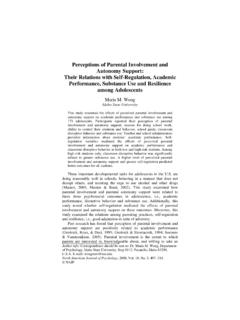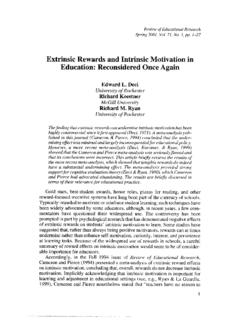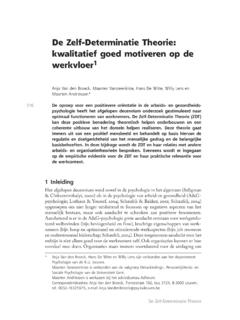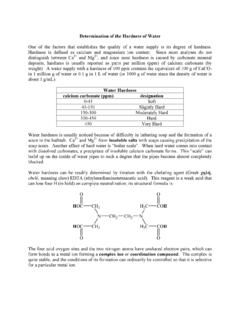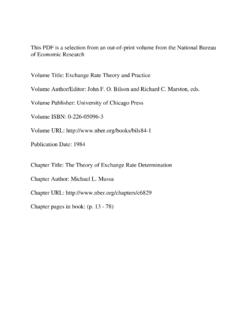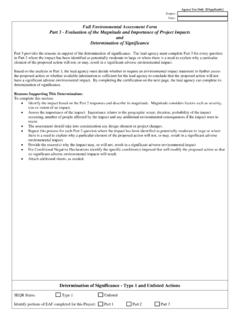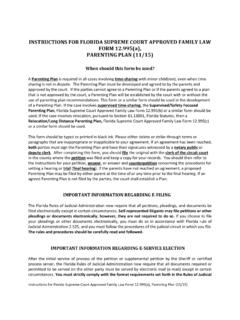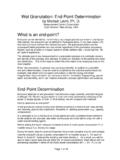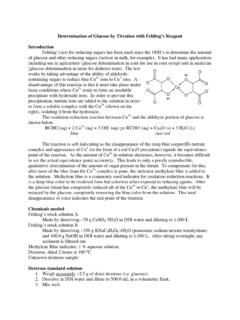Transcription of Motivation and Education: The Self-Determination …
1 Downloaded By: [EBSCOHost EJS Content Distribution] At: 21:48 28 May 2008 EDUCATIONAL PSYCHOLOGIST, 26(3 & 4), 325-346 Copyright O 1991, Lawrence Erlbaum Associates, Inc. Motivation and Education: The Self-Determination Perspective Edward L. Deci University of Rochester Robert J. Vallerand University of Quebec at Montreal LUG G. Pelletier University of Ottawa Richard M. Ryan University of Rochester Self-Determination theory (Deci & Ryan, 1985, 1991), when applied to the realm of education, is concerned primarily with promoting in students an interest in learning, a valuing of education, and a confidence in their own capacities and attributes.
2 These outcomes are manifestations of being intrin- sically motivated and internalizing values and regulatory processes. Research suggests that these processes result in high-quality learning and conceptual understanding, as well as enhanced personal growth and adjustment. In this article we also describe social-contextual factors that nurture intrinsic moti- vation and pralmote internalization, leading to the desired educational out- comes. In their formative first two decades, individuals spend about 15,000 hr in schools.
3 Thus schools represent a primary socializing influence that has enormous impact on the course of people lives and, in turn, on society. Ideal school systems are ones that succeed in promoting in students a genuine enthusiasm for learning and accomplishment and a sense of volitional involvement in the educational enterprise. It is this interest and volition, we suggest, that lead students to display greater flexibility in Requests for reprints should be sent to Edward L. Deci, Department of Psychology, University of Rochester, Rochester, NY 14627.
4 PDF processed with CutePDF evaluation By: [EBSCOHost EJS Content Distribution] At: 21:48 28 May 2008 problem solving, more efficient knowledge acquisition, and a strong sense of personal worth and social responsibility. The central features of optimal learning are conceptual understanding and the flexible use of knowledge. In other words, understanding both the relations among facts and the ways to find or generate facts are the learning outcomes that we stress. The acquisition and retention of facts are important but are by no means enough for excellent education.
5 Corre- spondingly, the central features of optimal adjustment are feeling good about oneself and acting volitionally to satisfy one's own needs while being attuned to and concerned about the social surround. Simply fitting in or complying with social demands is a nonoptimal form of adjustment and may even be counterproductive to personal and social development. These broad learning and adjustment outcomes are what we seek to promote in schools, and although these outcomes are sometimes considered independent or even antithetical, a body of motivational research, guided largely by Self-Determination theory ( , Deci & Ryan, 1985, 1991), has indicated that they are complementary when the school context stimulates certain kinds of Motivation in its students.
6 The highest quality of concep- tual learning seems to occur under the same motivational conditions that promote personal growth and adjustment. Self-Determination THEORY Behavioral Regulation Most current theories of Motivation have the concept of intention ( , Lewin, 1951) at their core. They are concerned with factors that promote (vs. fail to promote) people's understanding of behavior-outcome instru- mentalities and engaging in efficacious behaviors to attain those outcomes. This conceptual distinction between motivated and amotivated actions - in other words, between intentional and nonintentional behaving - has been described in various terms.
7 These include personal versus impersonal causality (Heider, 1958), voluntary responding versus helplessness (Seligman, 1975), and internal versus external locus of control (Rotter, 1966). Unlike most other theories, however, Self-Determination theory makes an important additional distinction that falls within the class of behaviors that are intentional or motivated. It distinguishes between self-determined and controlled types of intentional regulation. Motivated actions are self- determined to the extent that they are engaged in wholly volitionally and endorsed by one's sense of self (Deci & Ryan, 1991), whereas actions are controlled if they are compelled by some interpersonal or intrapsychic Downloaded By: [EBSCOHost EJS Content Distribution] At: 21:48 28 May 2008 force.
8 When a behavior is self-determined, the regulatory process is choice, but when it is controlled, the regulatory process is compliance (or in some cases defiance). The dimension that ranges from being self-determined to being controlled in one's intentional responding has also been described using the concept of perceived locus of causality (decharms, 1968; Ryan & Connell, 1989). When a behavior is self-determined, the person perceives that the locus of causality is internal to his or her self, whereas when it is controlled, the perceived locus of causality is external to the self.
9 The important point in this distinction is that both self-determined and controlled behaviors are motivated or intentional but their regulatory processes are very different. Further, as we show later, the qualities of their experiential and behavioral components are accordingly different. Human Needs Most current theories of Motivation focus on goals or outcomes and on the instrumentalities that lead to these desired outcomes ( , Bandura, 1977; Dweck, 1986; lEkcles, 1983). Such theories are concerned with the direction of behavior ( , with the processes that direct behavior toward desired outcomes), but they do not deal with the question of why certain outcomes are desired.
10 Therefore, they fail to address the issue of the energization of behavior. Unlike these other theories, Self-Determination theory does address the energization issue as well as the direction issue, and it does so by postulating about basic psychological needs that are inherent in human life. The theory focuses primarily on three such innate needs: the needs for competence, relatedness, and autonomy (or Self-Determination ). Competence involves understanding how to attain various external and internal outcomes and being efficacious in performing the requisite actions; relatedness involves developing secure and satisfying connections with others in one's social milieu; and refers to being self-initiating and self-regulating of one's own actions.
